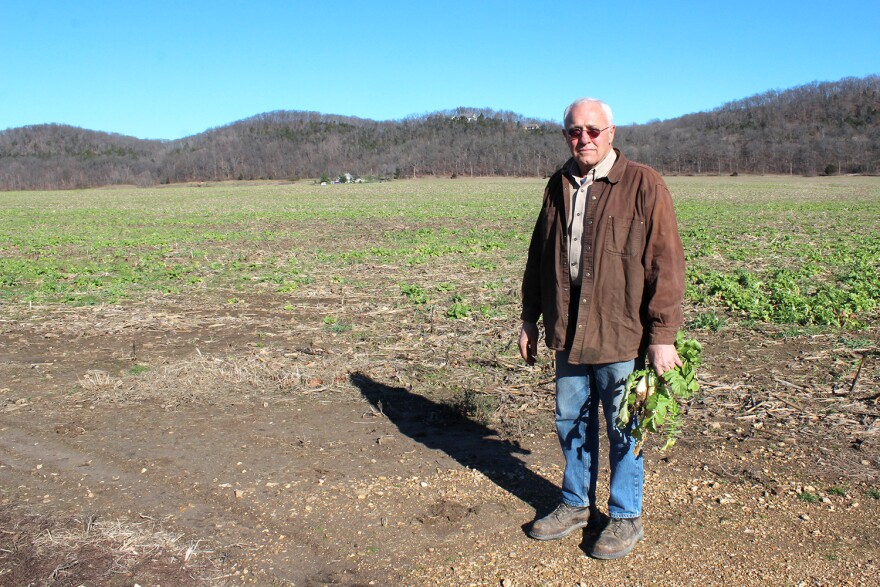The 2015 United Nations Climate Change Conference wrapped up in Paris over the weekend. While talking heads analyze the merits of the plan that came out of the meeting, farmers in the Midwest are thinking about the very real impact climate change is having on them.
Agriculture could be among the sectors hardest hit by a warming global climate, and farmers here already are having to adapt to changing weather patterns.

The Bardot family has been raising beef cattle in Franklin County, Mo., for about five generations. Roger Bardot takes care of 140 cows, plus a few bulls, and all of their calves. The cattle live outdoors year-round, so weather can have a big impact. “It’s probably the most limiting factor because we rely on grass so much,” Bardot said.
If his pastures don't get enough rain, the grass won’t grow well. But if too much rain comes too early — like the record-setting drenching of this past May through July — it can interfere with harvesting the cattle’s winter hay supply. “It was growing, but it rained every day," Bardot said. "And you have to get the hay dry before you can bail it so it doesn’t rot or mold."
Bardot thinks rainfall has been getting more erratic. So does Ed Heisel, who farms about 2,000 acres of corn and soybeans in Franklin County's Missouri and Meramec river valleys, where flooding can be a concern.
"Memory can be faulty, but it seems as though when you enter a drought or a wet season, they seem to be prolonged and more violent," Heisel said. "After we’ve had a long, dry spell and the rains return, you sometimes wonder if you really want it to happen or not because it never stops."

Missouri state climatologist Pat Guinan has looked at the data which show the state has, in fact, been getting more rainfall. “We’ve been witnessing, here in Missouri, an unprecedented wet period over the past few decades,” Guinan said. And more of that rain has been coming down in intense storms. “When you look at specific events, daily events where you have an inch or more of precipitation, or two inches or more, or three inches or more, all indicate a significant upward trend over the past 40 to 50 years,” Guinan said.
Too much rain at the wrong time can cause big problems, like this spring, when record-setting rainfall and chronically muddy fields kept about a fifth of Missouri’s potential soybean acreage from being planted.

It’s difficult to connect any particular extreme weather event to human-induced climate change. But it’s clear the climate is changing.
According to the 2014 National Climate Assessment, if emissions of carbon dioxide and other greenhouse gases continue to rise, the average annual temperature in Missouri could increase by about 4 degrees Fahrenheit by the middle of this century.
“To put that into perspective, that would be like taking today’s climate of Arkansas, and shifting it a few hundred miles to the north [...] into central Missouri," Guinan said.
For farmers, that would mean longer growing seasons, but also possibly new insect pests, diseases and weeds.
When it comes to climate change, Guinan sees drought as Missouri’s biggest vulnerability. He said you just have to look back a few years to see why.
“Two-thousand-and-twelve was a fairly short-lived drought," Guinan said. "It lasted less than a year, and yet we saw so many impacts. Agriculture took a huge hit. Livestock. Crops. The corn yield was about half the average.”

Purdue University civil engineer and hydrologist Keith Cherkauer believes the biggest challenge facing this part of the Midwest is going to be water management. Up until now, farmers in this region have mostly had to worry about getting water off their land. According to Cherkauer, they might have to do more of that in the future — but they will also need to find ways to store water for when the rains dry up.
“Where in the past we’ve relied on precipitation, it’s looking increasingly like we’re going to have to rely on irrigation,” Cherkauer said.

No matter how climate change ultimately affects weather here, Ed Heisel and Roger Bardot believe Missouri’s farmers will find ways to keep farming. "Oh, you know, I assume that we will adapt,” Heisel said.
“We just have to make the best of what we have and plan ahead," Bardot said. "Because everybody’s always going to have to have food, and there’s always going to be a need for production.”
But what kinds of food farmers will be able to produce here in the future — and what changes they’ll have to make to produce it — remains a question.
Follow Véronique LaCapra on Twitter: @KWMUScience








